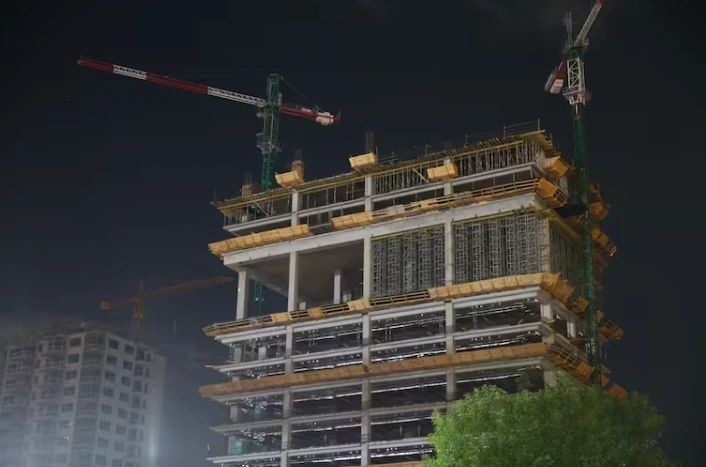BuySellBA
Administrator
One of the most listened to entrepreneurs in the real estate sector reveals the dark side of mortgage loans - La Nacion Propiedades

Source:

 www.lanacion.com.ar
www.lanacion.com.ar
June 23, 2025
By concentrating on the used market, prices rise and banks are quickly decapitalized. What is the AEV president's formula for ending the country's housing crisis?
By Carlos Spina

Carlos Spina, president of AEV, assures that the key is to move from financing stock to financing cash flow.fabian-malavolta-16567
Argentina is facing a structural housing crisis that has been going on for decades. The lack of long-term mortgage credit has turned access to housing into a privilege reserved for a select few. What should be a right, or at least a reasonable possibility for the majority, has become an increasingly distant prospect for young people, working families, and the middle class as well. Housing is, in any society, a central element of the economic and social fabric. It is the "social organizer." I want to elaborate on this concept: mortgage credit is not just a financial tool; it is an economic, social, and family organizer.

The lack of mortgage credit is driving young people, workers, and middle-class families out of the housing market.
Argentina not only suffers from a chronic housing shortage, but has become trapped in a vicious cycle. Demand is latent, but without credit, it doesn't become solvent demand ; and without it, suppliers only work for those who can afford to pay for a project during the project.
Thus, in the (few) credit windows that appear in Argentina, and by concentrating them on the used market, the price per square meter rises and millions are expelled from the possibility of accessing decent housing, while banks are rapidly decapitalized.

For years, the State absorbed most of the available savings, crowding out long-term private credit.
At the same time, the State , instead of promoting a mixed financial system, has occupied all available space for medium- and long-term savings (crowding out), absorbing resources and depriving private or mixed initiatives of their own. This has been changing in the last two years.
Can we now overcome the culture of short-termism in the youth economy? Without the possibility of capitalizing on durable goods like housing, they consume in the present what they could save for the future. As I warned, this is a "narcoticizing" consumption that does not build a future or wealth. On the contrary, mortgage loans do : they commit future income to a lasting good, allowing them to plan, take root, and build a life. In this context, it is urgent to move toward a modern, scalable, and sustainable housing financing model, focused exclusively on the development of new housing.

Without capitalization instruments, many young people prioritize immediate consumption over future investment.Unplash
The key is clear: shift from financing stock to financing cash flow . That is, using families' future income as a guarantee and not limiting themselves to the scarce pre-existing deposits in the system. This paradigm shift would allow for multiplying the volume of available credit, generating immediate economic activity, creating quality employment in more than 100 sectors related to construction, avoiding speculative bubbles, and laundering assets and workers. And something else: since these are new developments, they do not strain the BCRA's demand for dollars; on the contrary, unlike many sectors, as it grows, it does not demand more dollars but rather takes them out of the cushion. Construction requires few imported inputs; its stimulus is, in addition to being federal, economically prudent.
To this end, we propose a concrete model based on three pillars: first, 20-year, dual-indexed loans, combining inflation and wage growth, with a compensation fund (CER/CVS) that ensures a stable relationship between installments and income. Second, a mixed-financing system, in which banks, developers, and buyers share risks and benefits under transparent schemes , with fiduciary guarantees. Third, active state support through tax incentives for housing accessed through credit , and acting as a financing vehicle for multilateral organizations such as the IDB, CAF, or the World Bank (which could be the same compensation fund proposed).

The proposal aims to finance the future flow of family income to generate new housing supply.Soledad Aznarez - The Nation
This model is not a utopia: it is perfectly possible if institutionally organized. Between 2026 and 2031, Argentina can build an additional million homes if it scales up this system. Starting with 50,000 loans per year in 2026, it will gradually double that number until reaching more than 200,000 per year between 2029 and 2031. The impact is not measured only in bricks and mortar: it is measured in employment, in social stability, in economic dynamism, in social peace.
But for this plan to work, a federal coordination framework is also needed . Provinces must adhere to local regulations, facilitate the conversion of personal loans into mortgages at the time of deed signing without unnecessary delays , and create urban planning and tax incentive zones. The so-called "Opportunity Zones" will allow for the coordination of infrastructure planning, urban land, and financing, eliminating jurisdictions from functioning as silos. Positive competition between jurisdictions will reduce times, rates, and costs.

The new model provides for the joint participation of banks, developers and buyers, with support from the State and multilateral organizations. Canva
We also propose analyzing an innovative financing scheme for developments that complies with current legislation. Once the buyers have disbursed their down payment, the banks will provide the remaining financing in stages based on the progress of the project. The banks thus limit their exposure and gain traceability; the buyers enter the pool with an initial disbursement, assigning their personal rights to a security trust until the loan is converted into a mortgage loan at the time of signing the deed. Everything is transparent, auditable, and scalable. Everything is ready for institutional investors, both local and international, to participate with clear rules, expanding the operation.
We know there is macroeconomic uncertainty. We don't deny the risks: potential devaluations and/or falling real wages. But the solution to these challenges is not inaction, but rather the resilience of institutional design. The model we propose is designed to adapt to different scenarios, with automatic protection mechanisms and shared financing.
Housing is much more than an asset. It is family, stability, a life plan. It is the anchor that organizes the priorities of a person and a nation. Guillermo Oliveto's recent book, "Middle Class: Myth, Reality, or Nostalgia," warns of the impact on middle-class aspirations of the inability to access housing. Let's recover the thirst for growth. Let's choose to believe. Let's resolve complex issues in a simple and sustainable way and move on to much more complex problems. Those of us who are responsible for proposing public policies cannot continue to think that access to homeownership should be left to chance, individual effort, or episodic solutions.
This is not a sectoral demand: it's an institutional call. The starting point will be our debate at the upcoming Batev, the most important construction exhibition, but the challenge transcends the event. We call on the financial system, governors, national and municipal authorities, Congress, and civil society to build together a modern, sustainable, and federal mortgage credit system. Because without a roof, no republic can stand.
www.buysellba.com

Source:
Uno de los empresarios más escuchados del sector inmobiliario revela el lado B de los créditos hipotecarios
Al estar concentrados en el mercado del usado suben los precios y descapitaliza rápidamente a los bancos; cuál es la fórmula del presidente de la AEV para terminar con la crisis habitacional del país
June 23, 2025
By concentrating on the used market, prices rise and banks are quickly decapitalized. What is the AEV president's formula for ending the country's housing crisis?
By Carlos Spina

Carlos Spina, president of AEV, assures that the key is to move from financing stock to financing cash flow.fabian-malavolta-16567
Argentina is facing a structural housing crisis that has been going on for decades. The lack of long-term mortgage credit has turned access to housing into a privilege reserved for a select few. What should be a right, or at least a reasonable possibility for the majority, has become an increasingly distant prospect for young people, working families, and the middle class as well. Housing is, in any society, a central element of the economic and social fabric. It is the "social organizer." I want to elaborate on this concept: mortgage credit is not just a financial tool; it is an economic, social, and family organizer.

The lack of mortgage credit is driving young people, workers, and middle-class families out of the housing market.
Argentina not only suffers from a chronic housing shortage, but has become trapped in a vicious cycle. Demand is latent, but without credit, it doesn't become solvent demand ; and without it, suppliers only work for those who can afford to pay for a project during the project.
Thus, in the (few) credit windows that appear in Argentina, and by concentrating them on the used market, the price per square meter rises and millions are expelled from the possibility of accessing decent housing, while banks are rapidly decapitalized.

For years, the State absorbed most of the available savings, crowding out long-term private credit.
At the same time, the State , instead of promoting a mixed financial system, has occupied all available space for medium- and long-term savings (crowding out), absorbing resources and depriving private or mixed initiatives of their own. This has been changing in the last two years.
Can we now overcome the culture of short-termism in the youth economy? Without the possibility of capitalizing on durable goods like housing, they consume in the present what they could save for the future. As I warned, this is a "narcoticizing" consumption that does not build a future or wealth. On the contrary, mortgage loans do : they commit future income to a lasting good, allowing them to plan, take root, and build a life. In this context, it is urgent to move toward a modern, scalable, and sustainable housing financing model, focused exclusively on the development of new housing.

Without capitalization instruments, many young people prioritize immediate consumption over future investment.Unplash
The key is clear: shift from financing stock to financing cash flow . That is, using families' future income as a guarantee and not limiting themselves to the scarce pre-existing deposits in the system. This paradigm shift would allow for multiplying the volume of available credit, generating immediate economic activity, creating quality employment in more than 100 sectors related to construction, avoiding speculative bubbles, and laundering assets and workers. And something else: since these are new developments, they do not strain the BCRA's demand for dollars; on the contrary, unlike many sectors, as it grows, it does not demand more dollars but rather takes them out of the cushion. Construction requires few imported inputs; its stimulus is, in addition to being federal, economically prudent.
To this end, we propose a concrete model based on three pillars: first, 20-year, dual-indexed loans, combining inflation and wage growth, with a compensation fund (CER/CVS) that ensures a stable relationship between installments and income. Second, a mixed-financing system, in which banks, developers, and buyers share risks and benefits under transparent schemes , with fiduciary guarantees. Third, active state support through tax incentives for housing accessed through credit , and acting as a financing vehicle for multilateral organizations such as the IDB, CAF, or the World Bank (which could be the same compensation fund proposed).

The proposal aims to finance the future flow of family income to generate new housing supply.Soledad Aznarez - The Nation
This model is not a utopia: it is perfectly possible if institutionally organized. Between 2026 and 2031, Argentina can build an additional million homes if it scales up this system. Starting with 50,000 loans per year in 2026, it will gradually double that number until reaching more than 200,000 per year between 2029 and 2031. The impact is not measured only in bricks and mortar: it is measured in employment, in social stability, in economic dynamism, in social peace.
But for this plan to work, a federal coordination framework is also needed . Provinces must adhere to local regulations, facilitate the conversion of personal loans into mortgages at the time of deed signing without unnecessary delays , and create urban planning and tax incentive zones. The so-called "Opportunity Zones" will allow for the coordination of infrastructure planning, urban land, and financing, eliminating jurisdictions from functioning as silos. Positive competition between jurisdictions will reduce times, rates, and costs.

The new model provides for the joint participation of banks, developers and buyers, with support from the State and multilateral organizations. Canva
We also propose analyzing an innovative financing scheme for developments that complies with current legislation. Once the buyers have disbursed their down payment, the banks will provide the remaining financing in stages based on the progress of the project. The banks thus limit their exposure and gain traceability; the buyers enter the pool with an initial disbursement, assigning their personal rights to a security trust until the loan is converted into a mortgage loan at the time of signing the deed. Everything is transparent, auditable, and scalable. Everything is ready for institutional investors, both local and international, to participate with clear rules, expanding the operation.
We know there is macroeconomic uncertainty. We don't deny the risks: potential devaluations and/or falling real wages. But the solution to these challenges is not inaction, but rather the resilience of institutional design. The model we propose is designed to adapt to different scenarios, with automatic protection mechanisms and shared financing.
Housing is much more than an asset. It is family, stability, a life plan. It is the anchor that organizes the priorities of a person and a nation. Guillermo Oliveto's recent book, "Middle Class: Myth, Reality, or Nostalgia," warns of the impact on middle-class aspirations of the inability to access housing. Let's recover the thirst for growth. Let's choose to believe. Let's resolve complex issues in a simple and sustainable way and move on to much more complex problems. Those of us who are responsible for proposing public policies cannot continue to think that access to homeownership should be left to chance, individual effort, or episodic solutions.
This is not a sectoral demand: it's an institutional call. The starting point will be our debate at the upcoming Batev, the most important construction exhibition, but the challenge transcends the event. We call on the financial system, governors, national and municipal authorities, Congress, and civil society to build together a modern, sustainable, and federal mortgage credit system. Because without a roof, no republic can stand.
www.buysellba.com

